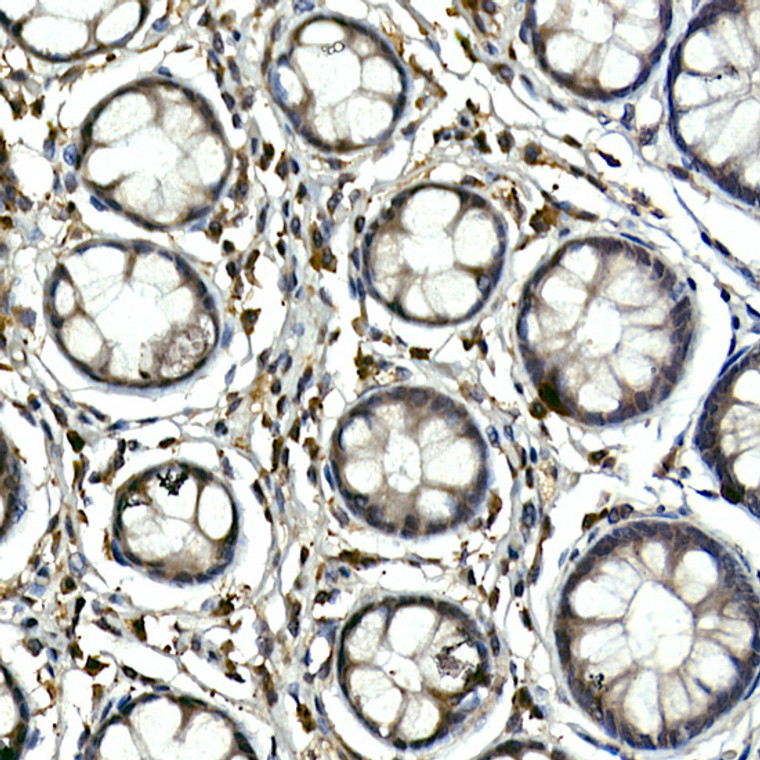| Host: |
Rabbit |
| Applications: |
WB/IHC/IF |
| Reactivity: |
Human/Mouse/Rat |
| Note: |
STRICTLY FOR FURTHER SCIENTIFIC RESEARCH USE ONLY (RUO). MUST NOT TO BE USED IN DIAGNOSTIC OR THERAPEUTIC APPLICATIONS. |
| Short Description: |
Rabbit polyclonal antibody anti-TEC (1-280) is suitable for use in Western Blot, Immunohistochemistry and Immunofluorescence research applications. |
| Clonality: |
Polyclonal |
| Conjugation: |
Unconjugated |
| Isotype: |
IgG |
| Formulation: |
PBS with 0.05% Proclin300, 50% Glycerol, pH7.3. |
| Purification: |
Affinity purification |
| Dilution Range: |
WB 1:500-1:1000IHC-P 1:50-1:200IF/ICC 1:50-1:200 |
| Storage Instruction: |
Store at-20°C for up to 1 year from the date of receipt, and avoid repeat freeze-thaw cycles. |
| Gene Symbol: |
TEC |
| Gene ID: |
7006 |
| Uniprot ID: |
TEC_HUMAN |
| Immunogen Region: |
1-280 |
| Immunogen: |
Recombinant fusion protein containing a sequence corresponding to amino acids 1-280 of human Tec (NP_003206.2). |
| Immunogen Sequence: |
MNFNTILEEILIKRSQQKKK TSPLNYKERLFVLTKSMLTY YEGRAEKKYRKGFIDVSKIK CVEIVKNDDGVIPCQNKYPF QVVHDANTLYIFAPSPQSRD LWVKKLKEEIKNNNNIMIKY HPKFWTDGSYQCCRQTEKLA PGCEKYNLFESSIRKALPPA PETKKRRPPPPIPLEEEDNS EEIVVAMYDFQAAEGHDLRL ERGQEYLILEKNDVHWWRAR DKYGNEGYIPSNYVTGKKS |
| Tissue Specificity | Expressed in a wide range of cells, including hematopoietic cell lines like myeloid, B-, and T-cell lineages. |
| Post Translational Modifications | Following B-cell or T-cell receptors engagement, translocates to the plasma membrane where it gets phosphorylated at Tyr-519. Undergoes also tyrosine phosphorylation during platelet activation. |
| Function | Non-receptor tyrosine kinase that contributes to signaling from many receptors and participates as a signal transducer in multiple downstream pathways, including regulation of the actin cytoskeleton. Plays a redundant role to ITK in regulation of the adaptive immune response. Regulates the development, function and differentiation of conventional T-cells and nonconventional NKT-cells. Required for TCR-dependent IL2 gene induction. Phosphorylates DOK1, one CD28-specific substrate, and contributes to CD28-signaling. Mediates signals that negatively regulate IL2RA expression induced by TCR cross-linking. Plays a redundant role to BTK in BCR-signaling for B-cell development and activation, especially by phosphorylating STAP1, a BCR-signaling protein. Required in mast cells for efficient cytokine production. Involved in both growth and differentiation mechanisms of myeloid cells through activation by the granulocyte colony-stimulating factor CSF3, a critical cytokine to promoting the growth, differentiation, and functional activation of myeloid cells. Participates in platelet signaling downstream of integrin activation. Cooperates with JAK2 through reciprocal phosphorylation to mediate cytokine-driven activation of FOS transcription. GRB10, a negative modifier of the FOS activation pathway, is another substrate of TEC. TEC is involved in G protein-coupled receptor- and integrin-mediated signalings in blood platelets. Plays a role in hepatocyte proliferation and liver regeneration and is involved in HGF-induced ERK signaling pathway. TEC regulates also FGF2 unconventional secretion (endoplasmic reticulum (ER)/Golgi-independent mechanism) under various physiological conditions through phosphorylation of FGF2 'Tyr-215'. May also be involved in the regulation of osteoclast differentiation. |
| Protein Name | Tyrosine-Protein Kinase Tec |
| Database Links | Reactome: R-HSA-1433557Reactome: R-HSA-2871809Reactome: R-HSA-512988 |
| Cellular Localisation | CytoplasmCell MembranePeripheral Membrane ProteinCytoskeletonFollowing B-Cell Or T-Cell Receptors Activation By AntigenTranslocates To The Plasma Membrane Through Its Ph DomainThrombin And Integrin Engagement Induces Translocation Of Tec To The Cytoskeleton During Platelet ActivationIn Cardiac MyocytesAssumes A Diffuse Intracellular Localization Under Basal Conditions But Is Recruited To Striated Structures Upon Various StimuliIncluding Atp |
| Alternative Antibody Names | Anti-Tyrosine-Protein Kinase Tec antibodyAnti-TEC antibodyAnti-PSCTK4 antibody |
Information sourced from Uniprot.org
12 months for antibodies. 6 months for ELISA Kits. Please see website T&Cs for further guidance












